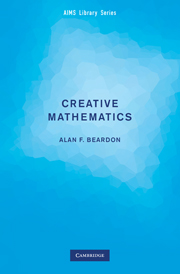19 - Problem D: Discussion and Generalisations
Published online by Cambridge University Press: 16 May 2024
Summary
First, we solve the problem for the tetrahedral dice, where the labels can now be non-negative integers. We argue exactly as before: we let
where now the ai and bj may be zero, and we obtain the same identity, namely
This gives a finite number of possibilities for P and Q, but our choices of P and Q must satisfy the constraint P(1) = 4 = Q(1). With this constraint there are nine possibilities, but if we reject the cases that are obtained by interchanging P and Q from some other case, the list reduces to the following five possibilities for the pair P(x),Q(x):
These give the solutions as
These are the only solutions to the problem. It is interesting to note that each of these solutions is obtained from one of the positive solutions ﹛1, 2, 2, 3﹜ and ﹛1, 3, 3, 5﹜ by adding 1 to each label on one die, and subtracting 1 from each label on the other die. In retrospect, we should have seen, and remarked, at the start that this process will give us additional solutions.
The same technique can be used to solve the problem with a pair of standard (cubic) dice with faces labelled 1, … , 6. The possible totals are 2, 3, … , 12, and the frequency distribution of these totals can be found directly from the identity
Thus, to solve the problem of relabelling a pair of cubic dice, we must find non-negative integers a1, … , a6 (on the first die), and b1, … , b6 (on the second die), such that
As before, we write
and we have to find positive integers ai and bj such that
subject to the constraints P(1) = Q(1) = 6.
We may assume that a1 ≤ a2 ≤ · · · ≤ a6, and similarly for the bj , and we must have a1 = b1 = 1 (so that both P and Q have a factor x) and a6 + b6 = 12. It follows that we must have
- Type
- Chapter
- Information
- Creative MathematicsA Gateway to Research, pp. 83 - 86Publisher: Cambridge University PressPrint publication year: 2009



